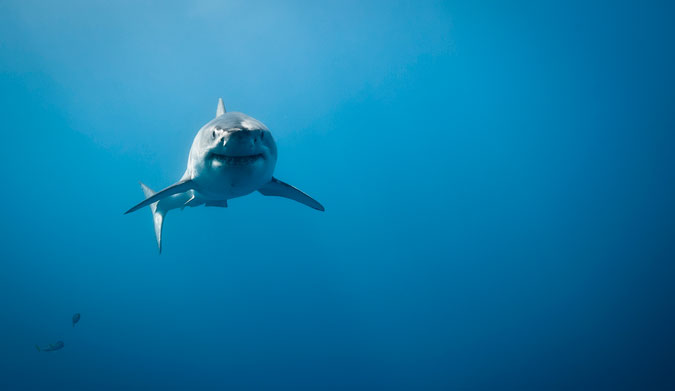
You have a better chance of drowning than being eaten by this. Photo: Shutterstock
Last week, I went for a surf at my local Bondi. It was early on a Monday morning, it was onshore, a bit rainy and waves were not too amazing. Nevertheless, we were surprised to find Bondi absolutely empty. We were stoked to have the beach to ourselves. (In case you don’t know Bondi, that never happens. Even on the worst days, there’s still a crowd). Ten minutes later, two mates paddled out and they told us the reason behind the strangely empty line-up was an earlier shark sighting. While I felt a little uncomfortable, none of my mates seemed to be too bothered about the news. I was kind of torn between catching a few waves and the slight anxiousness building up in my belly. Eventually, I ended up staying out for a bit longer. It’s a pretty big ocean, after all, and what are the chances, really?
No summer passes without media reporting countless shark sightings and the odd shark attack. It seems they are waiting for an attack to happen so they can report on it in all its gory details and the personal tragedies accompanying it. I try not to listen too much to media shark frenzies and stay level headed when I hear about another shark story.
Admittedly, as a surfer I was horrified though to hear about the recent shark attack on Tadashi, a surfer from Ballina, who had his legs bitten off sitting in the water on his board. It did shake my confidence in my “what are the chances” and “it’s just all media” theory a bit. So I did some research on some of the questions that popped into my head to give myself some peace of mind again.
Are there more sharks around?
You hear of a lot of sharks around at the moment, especially on the east coast of Australia. But according to Taronga Conservation, shark populations are generally considered to be in steep decline due to overfishing. Observing a large number of sharks in an area does not mean there is a shark population increase, but rather it is more likely due to a congregation of sharks feeding in an area.
Are the shark attacks on the increase?
Well, if you look at numbers in an absolute way, then there is no denying that there was a bit of a spike in shark attacks recently in Australia.
However, if you think about it in relative terms, i.e. the number of people spending time in the ocean these days compared to say, a 100 years ago, is much higher. An encounter between human and shark is therefore much more likely, but still the shark attack file only averages at about 1.38 fatal attacks a year over the last 100 years. Technically, shark attacks are decreasing when compared to the number of people in the ocean.
What are the chances really?
According to the Australian Shark Attack File, in the last 100 years in Australia, there were 532 unprovoked shark attacks, 138 of which were fatal. 299 people injured, and 95 were uninjured.
Back in 2010, according to Surfing Australia, there were 2.7 million recreational surfers in Australia. In the five years since, it’s likely that the population of surfers has increased. It doesn’t say how many of the fatal attacks were surfers, but assuming out of the average yearly 1.38 fatal attack, it’s one surfer.
So the odds to get eaten by a shark as a surfer in Australia is about 1 in 2.7 million. Admittedly, that’s based on my slightly wonky assumptions, but you get the gist. Even as a surfer who spends a lot of time in the water, the risk is pretty low.
And to put things a bit more in perspective, did you know that around 300 people a year drown in Australia? And 20 people a year die from horse riding accidents, and around 10 people per year in Australia die from bee stings?
How to minimize risks?
But odds are still odds, and there are ways to minimize the minimal risks. As surfers, we just spend more time in the water than the average person. We are more exposed to a potential shark attack, so here are a few rules to follow:
1. Get out of the water when there has been a confirmed shark sighting.
2. Don’t surf at dusk or dawn by yourself. The official recommendation is to not to surf at dusk or dawn at all but let’s be real–that’s the best time of the day for a surf and the most feasible to time for 9-5ers.
3. Listen to your gut. If it feels sharky, get out. It doesn’t pay to ignore instinct.

